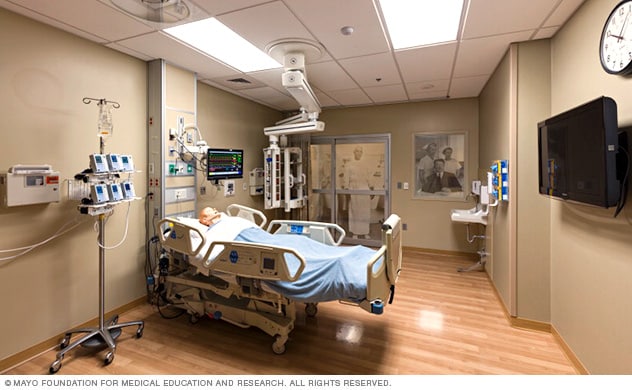Education and Research
The Multidisciplinary Simulation Centers at Mayo Clinic incorporate four elements of simulation in health care:
- Simulation education
- Simulation assessment
- Simulation-based research
- Systems integration
Simulation education
Simulation education bridges classroom learning and real-life clinical experience. Clinician faculty members provide expert knowledge and ensure that learning objectives are met.
The Mayo Clinic Multidisciplinary Simulation Centers use live actors, realistic manikins and task trainers that simulate specific functions. Computerized manikins are programmed to meet the learning needs of novices and more advanced students, and perform dozens of human functions realistically.
The centers' patient care units reproduce hospital settings such as the operating room or critical care unit, including the availability of patient care equipment and technology. This detailed replication allows learners to fully immerse themselves in the simulation and distinguish simulation training apart from simple demonstration and practice learning.

Emergency department and intensive care unit training room
Simulation assessment
Simulation-based assessment refers to both learning for improvement and testing to determine competency. Demonstrating competence by accurately simulating patient care skills and tasks has become an indispensable part of effective evaluation.
Future directives for medical societies' credentialing protocol indicate that it will eventually be more meaningful to actually demonstrate competency than to provide a surrogate for competency as has been traditionally done in the past via multiple-choice tests and oral exams.
The Mayo Clinic Multidisciplinary Simulation Centers allow learners to develop and demonstrate clinical skills in cutting-edge facilities to meet the evolving demands of the health care industry.
Simulation-based research
Researchers use simulation-based research to reach a number of goals. For example, simulations can help scientists understand why a particular event happened, test new medical devices under a range of conditions before the final device is marketed and used on patients, study new procedures for giving dangerous drugs, or develop and refine advanced resuscitation methods.
The Mayo Clinic Multidisciplinary Simulation Centers can represent variables such as populations, tests and costs as data patterns in our computers, allowing researchers to run multiple simulation scenarios to find optimal solutions for maximal health in individuals or communities. Different types of simulations — live, virtual reality or computer-based — can be combined to address a research question from different angles.
Systems integration
Systems integration refers to the integration of simulation into institutional health care training and delivery systems.
Simulation-based processes may include quality assessment mechanisms, facilitating patient safety. Simulation may also raise the bar for objectivity and fairness in evaluation, substituting visible, accepted metrics for performance for anecdotes and opinions.
Simulation-based approaches can be integrated into institutional processes to help evaluate organizational, individual and team performance. Examples include testing disaster response procedures or trying out a new patient care procedure before it's put into practice.
Resources
Find resources and simulation information from the Mayo Clinic Multidisciplinary Simulation Centers.
- Mechanical Ventilation Guide (PDF)
- Healthcare Simulation Dictionary. Lopreiato JO (ed.), Downing D, Gammon W, Lioce L, Sittner B, Slot V, Spain AE (associate eds.), and the Terminology & Concepts Working Group. (2016). Retrieved from http://www.ssih.org/dictionary.